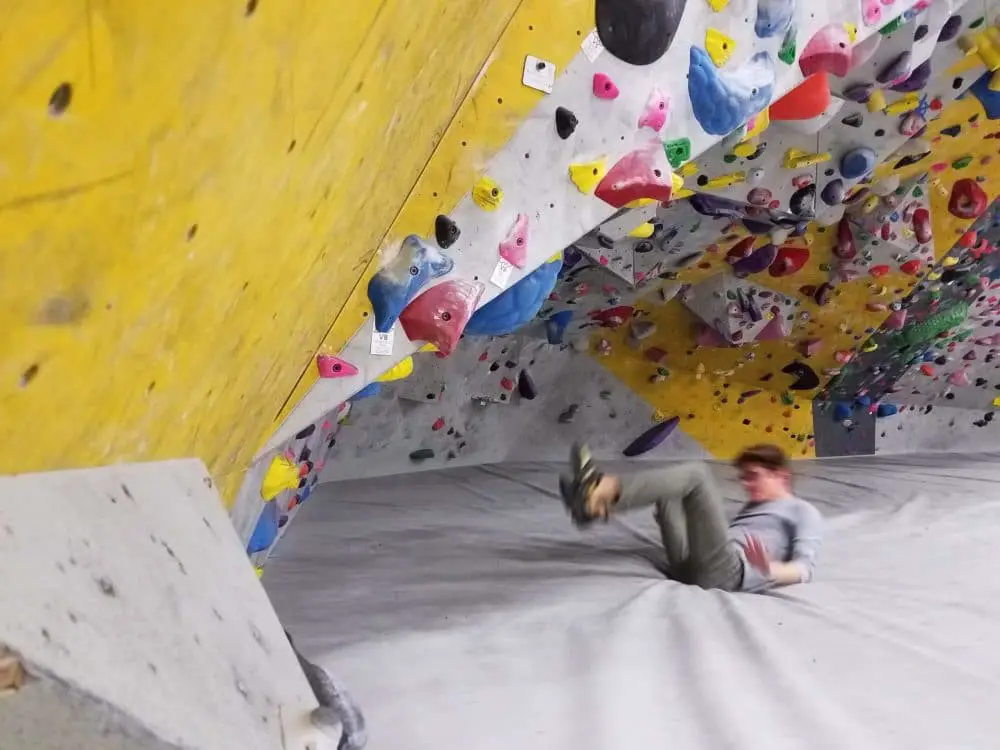Rock climbing is an excellent way to meet people, build mental fortitude, and get good exercise, but it can be difficult for a novice to get into climbing. If heights bother you, or if you don’t want to invest in a lot of expensive gear and training, bouldering is the way to go.
Regular bouldering, both in the gym indoors and outside is safer than the more dangerous forms of climbing like free soloing, high-ball bouldering, and arguably trad climbing. While the chance of dying is minimal, there is a fairly high chance of feet, ankle, and leg injuries, as well as finger overuse injuries.
Fortunately, there are a few techniques you can easily learn and practice that will help reduce the risk of injuries from bouldering. These include: clearing the landing zone, learning to fall, and knowing your limits. We review each of these and offer advice below.
Bouldering Safety
A study done by Dr. Volker Schoffl , involving more than 500,000 visits to a climbing gym in Germany, indicated that the risk of a severe or fatal injury when climbing indoors are extremely low. While the results didn’t specify between rock climbing and bouldering, the overall conclusion was clear- everybody should rock climb and boulder!
, involving more than 500,000 visits to a climbing gym in Germany, indicated that the risk of a severe or fatal injury when climbing indoors are extremely low. While the results didn’t specify between rock climbing and bouldering, the overall conclusion was clear- everybody should rock climb and boulder!
Common Bouldering Injuries
Unfortunately, injuries are just a part of bouldering. The most common injuries are small things like twisted ankles and tendonitis in the hands and forearms, and the most severe include head injuries and broken bones.
Among my group of climbing buddies, I know a husband and wife who have both broken their legs while bouldering. One happened when he fell and landed on a rock between two crash pads, and the other one happened when someone wandered beneath her as she was bouldering in a gym and she fell.
Most bouldering injuries, of course, come from falls. Outdoors, this may happen when someone misses a pad, or when they roll off of the pad. Sometimes a crash pad is too thin for the height of the problem.
Gyms generally have a really thick mat that will keep you from getting hurt as long as you learn to fall correctly. When bouldering outdoors, no one wears helmets. Falling from just a few feet up and landing your head on a rock can really cause a severe injury.
The other kind of minor injury that happens frequently with bouldering is varying forms of tendonitis resulting from overuse. Sometimes aspiring climbers progress too quickly and put too much strain on their tendons.
It’s important to allow time for your body to build up to the serious strains that you are putting on it by bouldering. The solution is usually to rest and recover. There are many different grip strength exercises you can do to strengthen your hands as you get into bouldering and climbing.
you can do to strengthen your hands as you get into bouldering and climbing.
When you’re first starting out, a good day at the gym will always lead to some ‘flappers‘ (torn calluses) on your fingers and hands. While your hands will toughen up eventually, it’s helpful to use some climbing salve like this to help your hands heal faster. You should also use athletic tape like this one from Metolius
to help your hands heal faster. You should also use athletic tape like this one from Metolius  to protect raw spots on your hand from getting torn open further. (Click to view on Amazon)
to protect raw spots on your hand from getting torn open further. (Click to view on Amazon)

Is Rock Climbing Safer than Bouldering?
It all really comes down to how you define “safe.” While we usually think of driving a car and flying in an airplane as safe, people get hurt and die all the time. The study mentioned earlier in this article found that indoor climbers averaged .02 injuries per 1000 hours logged in a gym. Lots of other activities have higher injury rates including surfing and badminton !
!
People think of bouldering as the safe alternative to rock climbing, so it is measured in the same frame of reference. I’ve written extensively about the dangers of rock climbing and why the public thinks it is more dangerous than it actually is (thank you Alex Honnold
about the dangers of rock climbing and why the public thinks it is more dangerous than it actually is (thank you Alex Honnold ).
).
While injuries do happen semi-frequently, from twisted ankles to broken bones, deaths are what capture the headlines and create the ‘digital echo’ that rock climbing is an adrenaline-filled dangerfest.
No one would blink twice if an article came through your social media feed or ran in a newspaper reporting that someone had broken his ankle bouldering. If someone died though, then it would be all over the place. This lack of serious injuries and deaths helps people believe that bouldering is safer than rock climbing.
I wrote about the number of deaths in rock climbing overall in this article: How Many People Die Rock Climbing?
Rock Climbing v Bouldering
While rock climbing clearly has more fatalities than bouldering does, bouldering has a higher injury rate. This is simply because ropes do their job of protecting falling climbers. The only time accidents really happen to rock climbers is when someone makes a mistake like forgetting to tie a stopper knot or not paying attention on a belay.
Other then that, there is always the freak chance of a rockfall hitting a climber or severing a rope. Ropes limit the chance of a groundfall, which limits the likelihood of an injury.
With bouldering however, 100% of climbs result in a groundfall. While we can do a lot to protect falls with big pads and spotters, it’s not perfect. Our bodies really just aren’t built to fall 5-10ft (2-3m) over and over again.
If you fall from the middle or top of a problem and land on your wrist, it will snap! Again, most injuries that I have seen from bouldering are simple twisted ankles.
If something goes wrong while you’re bouldering, you’re a short distance from the ground. If it goes wrong while rock climbing, you have a lot longer distance to fall.
Additionally, rock climbers usually wear helmets. This is to protect from falling rock and accidental whippers, but also serve to cushion your head in the event of a groundfall. With bouldering, all you have is a spotter and a crash pad.
Rock climbing and bouldering both involve different kinds of risk, and different kinds of injury potential. It’s important to know what you can do to minimize and mitigate the inherent dangers by practicing safe techniques.

Tips for Bouldering Safely
1. Clear the Landing Zone
A good crash pad and attentive spotter will protect you from any serious injury. Unfortunately, not all bouldering problems have a nice open space at the bottom that is free of rocks, and not everyone has the luxury of a good spotter.
It’s really important to clear out the landing zone as well as you can before you start bouldering. Move any rocks or sticks out of the way, and make sure your own gear like water bottles, backpacks, or shoes are off to the side.
It’s also important to do this in a gym- with lots of people around you never know when someone will inadvertently walk underneath you. It’s good to have someone with you to keep the landing clear, though isn’t always common. Practice good spotting techniques, and use a spotter whenever possible.
2. Learn how to Fall Correctly
Falling from 15ft (5m) and landing on your wrist or the side of your ankle will definitely cause a sprain or even a break- even if you fall on a big pad. When you go to a bouldering gym for the first time they will teach you how to fall correctly to minimize your chance of getting hurt. Practice this a few times and remember the basic techniques.
You need to get comfortable rolling or collapsing your legs when you land. This does a better job dispersing the kinetic energy from your fall instead of forcing it into your legs. If you try to stick the landing you are more likely to injure yourself.
You need to be especially aware of the chance of your knees hitting your chin when rolling. Downclimb whenever you can to a lower height that you feel comfortable jumping from.
3. Know Your Limits
Don’t get caught up in comparing yourself to others. Most injuries, especially outdoors, probably happen when people try to show off or send problems outside of their comfort zones.
Downclimb from the top whenever possible before jumping, and don’t make a precarious move without planning your fall. Avoid repetitive-strain injuries by taking rest days as needed.
Indoor Climbing Gym Deaths
Among the 4 indoor rock climbing fatalities that have been recorded since 2000, none of them were from bouldering. I’ve included links to the articles if it’s something you’d like to read. The important thing is to learn from the mistakes and renew your commitment to bouldering and climbing safely.
2003 Death – Improper maintenance of a carnival climbing wall
– Improper maintenance of a carnival climbing wall
2013 Death – Forgot to clip into auto-belay
– Forgot to clip into auto-belay
2014 Death – Reason unknown; fall
– Reason unknown; fall
2018 Death – Reason unknown; head injury
– Reason unknown; head injury
Is Bouldering Indoors Safer than Bouldering Outdoors?
The main dangers with bouldering outdoors stem from the remote nature of outdoor climbing. If a fall or serious abrasion happens in a gym, medical care is close by. If it happens at a crag after a long hike in, the danger increases quickly.
Other factors like weather conditions and loose rock increase the risk of bouldering outside, which are obviously negated when gym climbing. The other huge difference between gym bouldering and outdoor bouldering is the prevalence of crash pads. It’s hard to beat the big thick gymnast mats that cover the whole floor in a bouldering gym, but you do have to watch out for people walking beneath you.
If you do spend a lot of time bouldering outdoors, you should make sure someone always knows where you’re going and when to call in a rescue if you don’t return. Some bouldering areas are extremely popular and some are completely isolated and hard to get to.
I recommend carrying a Spot Messenger or other satellite communication device so you can call in help if a disaster strikes in the backcountry. Take a look at our Recommended Gear Page
or other satellite communication device so you can call in help if a disaster strikes in the backcountry. Take a look at our Recommended Gear Page for more emergency essentials.
for more emergency essentials.

Related Questions
How High Are Bouldering Walls? Indoor bouldering walls are usually less than 20ft (6m) high. Outdoor bouldering problems vary in height, but usually top out at about 15ft (5m). Anything above 30ft (10m) is a “high-ball” bouldering problem and is comparable to free soloing.
Is Indoor Rock Climbing Scary? Most people have a natural fear of heights that can be difficult to overcome. Once a climber learns to trust the ropes and equipment, they learn that there is very little danger and very little fear.
Read these Climbing Articles Next
Is Indoor Rock Climbing a Good Workout?
How Can I Make my Climbing Shoes Last Longer?
How Much Do Rock Climbers Weigh?
Is Speed Climbing Always the Same Route?
What to Eat Before Indoor Rock Climbing According to a Dietitian

